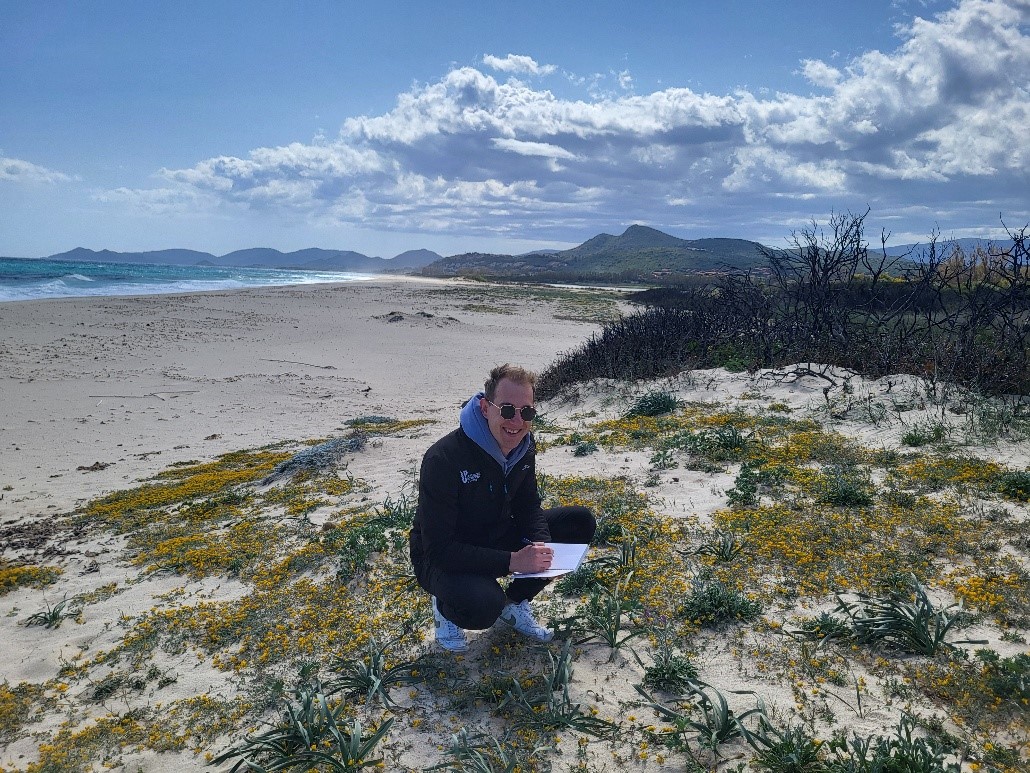

Michał Arciszewski
3rd year of education at the Doctoral School
Discipline: Biological Sciences
University of Cagliari, Centre for the Conservation of Biodiversity (CCB)
Between March 10 and April 11, 2025, I completed a scientific internship at the Centre for the Conservation of Biodiversity (CCB), operating within the Department of Life and Environmental Sciences at the University of Cagliari. The scientific supervisor of the internship was Prof. Gianluigi Bacchetta. The goal of the internship was to acquire both theoretical knowledge and practical skills related to the conservation of endangered plant species and the functioning of a seed bank.
 Pic. Monitoring populations of endangered endemic plant species.
Pic. Monitoring populations of endangered endemic plant species.
During the internship, I participated in numerous field and laboratory activities. One of the main tasks was the monitoring of endangered plant species populations in dune ecosystems and coastal lagoons of Sardinia. This work involved assessing population size, individual plant condition, habitat characteristics, and threats arising from anthropogenic activity and climate change. As part of these activities, I was also involved in identifying and evaluating the impact of invasive and alien species on natural coastal habitats. The analysis of these interactions was crucial for the protection of native flora and maintaining ecosystem integrity.
Another important element of the internship was the identification of plant species typical of wetland areas. The fieldwork allowed me to deepen my floristic knowledge and apply plant identification methods in practice.
A key component of the internship was work conducted at the Sardinian Germplasm Bank (BG-SAR). During laboratory sessions, I learned techniques for cleaning, sorting, and preparing seeds for long-term storage. I also became familiar with seed storage protocols, including dehydration processes, quarantine procedures, and controlled storage conditions. This knowledge is particularly relevant to the ex situ conservation of endangered plant species.
The final stage of the internship focused on seed germination research. I participated in experiments aimed at evaluating the conditions that influence germination efficiency, including temperature, humidity, and the presence of heavy metals in the environment. I analyzed the impact of metals on seed germination and the early development of seedlings.
The internship proved to be a valuable scientific and practical experience. It enabled me to acquire specialized skills in plant ecology, the biological foundations of conservation, and seed storage technologies. The knowledge gained will be directly applied in my ongoing research, particularly in the context of conserving relict willow species (Salix lapponum and Salix myrtilloides) in Poland.
In addition to the rich scientific program, the internship in Cagliari was also an excellent opportunity to explore the culture and natural environment of Sardinia. In my free time, I was able to visit many fascinating places that reflect the unique character of this region.
One of the most captivating experiences was a visit to the Molentargius – Saline Regional Park, located in close proximity to the city. This area is of exceptional natural value and serves as a habitat for numerous species of water birds, including colonies of pink flamingos, which can be observed in their natural environment. The park also plays a key role in wetland conservation and ecological education.
I also visited Poetto Beach – one of the longest urban beaches in Europe and a popular recreational spot for both locals and tourists. The beach offers not only excellent conditions for relaxation but also stunning views of the Mediterranean Sea and the picturesque Sardinian coastline. A memorable experience was hiking to the top of Sella del Diavolo, from where there is a panoramic view of the Gulf of Cagliari and the surrounding lagoons.
Pic. Botanic Garden of University in Cagliari ( Office of the Center for Biodiversity Conservation and the Sardinia Seed Bank)
Cagliari, as a city with a rich history, also captivates with its religious architecture. During my stay, I visited several churches and cathedrals, including the Cathedral of Saint Mary in the Castello district, which combines Romanesque, Gothic, and Baroque elements. These sacred buildings not only impress with their architecture but also bear witness to the island’s centuries-old cultural heritage.
Therefore, the internship in Cagliari was not only a valuable professional experience but also an opportunity to connect with the nature, history, and culture of southern Sardinia — enriching my stay with unforgettable and invaluable experiences.
This foreign mobility has been supported by the Polish National Agency for Academic Exchange (NAWA) under the STER programme: „Actions towards the internationalization of the Doctoral School of the University of Life Sciences in Lublin (I-SDUPL)”.

Vist report (.pdf)
University of Life Sciences in Lublin
13 Akademicka Street, 20-950 Lublin
VATIN 712 010 37 75
REGON no. 000001896
ePUAP: /UP-Lublin/SkrytkaESP
